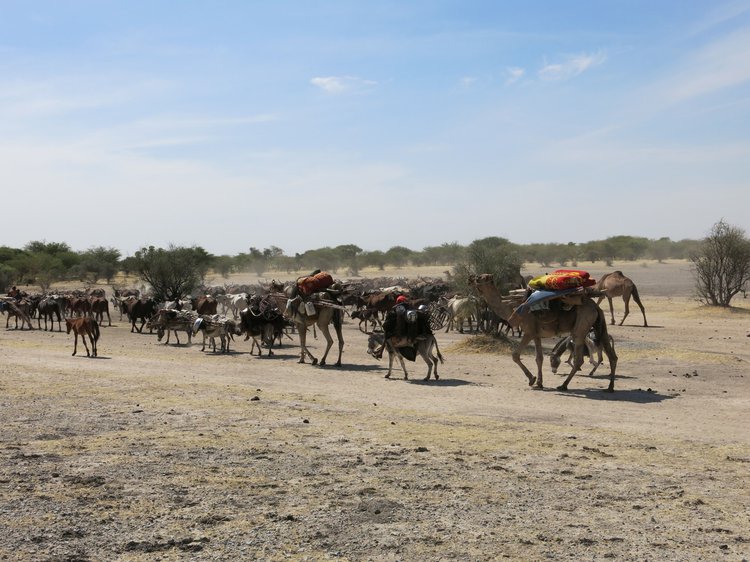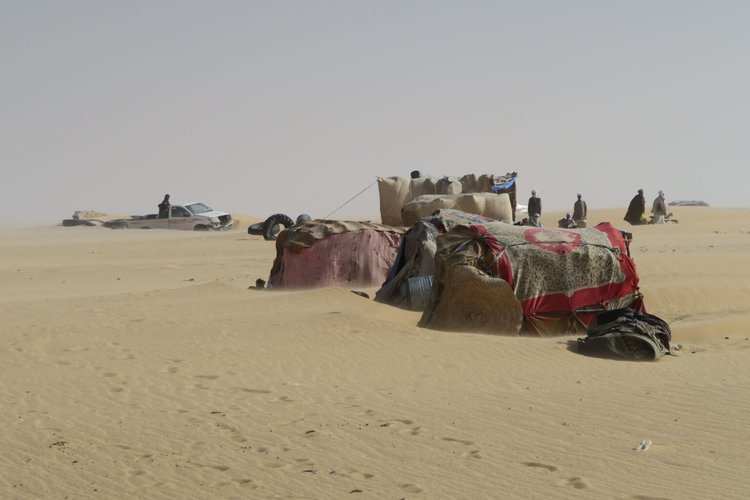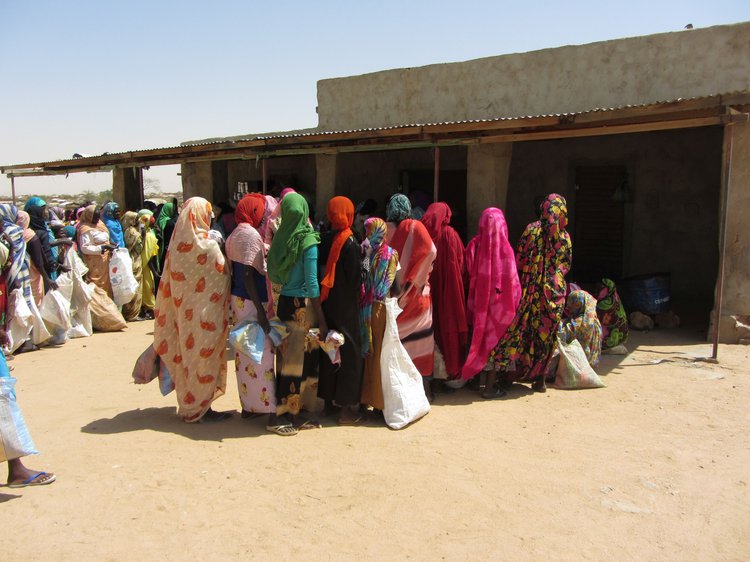Chad
Published May 15th, 2021 - written by: Helga Dickow
supported by Magdalena Maier and Malte Jursch, published in May 2021
Background and brief characterisation
Chad is a landlocked country sharing borders with Libya, Niger, Nigeria, Cameroon, the Central African Republic (CAR) and Sudan. Chad has close ties with France, the former colonial power (Chad gained independence on 11 August 1960). With an estimated population of 16 million in 2019, the majority of Chadians live in the southern region of the country and in the capital N'Djamena. The population is divided into approximately 200 ethnic groups with different languages and traditionally different ways of life (pastoralism/transhumance, agriculture, crafts). The official languages are French and Chadian Arabic. According to its constitution, Chad is a secular state. About 60% of the population professes to practice Islam and 40% Christianity.
Economy and government
Chad has never experienced a peaceful transition of power. President Idriss Déby Itno (as of August 2020, the additional title of Field Marshal was still conferred on him) overthrew his former army chief and president at the time, Hissène Habré, in 1990 and has remained in power ever since. Habré was sentenced to life imprisonment in Senegal in 2017 for crimes and human rights violations committed during his rule, but his victims have yet to receive compensation. Initially, high hopes were placed in Déby: he promised democratisation and the opening up of the country, allowed political parties and held the first elections in 1996. Like all subsequent elections, they were won by Déby and his party, the Patriotic Salvation Movement (MPS), which emerged from the rebel movement. Allegations of fraud, however, have accompanied all the elections.
In the meantime, Déby was so successful that the manipulation of the electoral authorities and repression of the opposition during the campaign was enough to win the vote on election day. Several constitutional amendments (2005 and 2018) would have given him a sixth term with re-election on 11 April 2021, and a possible term until 2034. However, on 20 April 2021 a Transitional Military Council (TMC), led by his son Mahamat Idriss Déby, unexpectedly announced Idriss Déby's death. He was killed in an attack by a Chadian rebel alliance (Front pour l'alternance et la concorde au Tchad), led by Mahamat Mahadi Ali, which had been advancing towards N'Djamena since election day. The Transitional Military Council relies on the military and power structures of the Déby government. Despite promises of democratic elections after a transitional period of 18 months (renewable once), democratic change does not seem to be the primary objective of the TMC, but rather the continuity of the rule of the Zaghawa ethnic group around the old and new Déby. After the funeral ceremonies, demonstrations against the new leaders and the continuity of the positions of the Zaghawa elite have taken place several times in all cities of Chad since the end of April 2021. The military and police have shot at civilians and many people have died.
Oil has been produced in Chad since 2003. However, the hopes of the population to see their living conditions improve have not been fulfilled. Only the power elite around the president has benefited from the oil revenues and enriching themselves with real estate and with cash in foreign accounts. However, Déby (Senior) also used these revenues to secure his power by expanding the security apparatus and using financial incentives to incorporate political opponents. According to Transparency International, Chad is one of the most corrupt countries in the world. There is no industry worthy of the name; the majority of the population lives on subsistence agriculture and livestock. After oil, cotton and livestock are Chad's most important exports. In addition to the oil deposits in the south of the country (which will soon be exhausted), there are gold deposits in the north of the country that have not yet been professionally explored.
Chad ranks low on all indices, whether it is political freedoms, rule of law, corruption or poverty. The Freedom House 2020 report describes Chad as "not free" and ranks it 17th, with the 2020 Human Development Index in second-to-last place.The majority of the population lives below the poverty line.
Déby used the advance of Islamist terrorist groups in the region and in the Sahel to establish himself as an indispensable ally in the fight against Islamist terror thanks to his well-equipped army. The army has received international and regional recognition for this, notably from France and the heads of state of the other G5 countries (Burkina Faso, Mali, Mauritania and Niger). Chadian military personnel constitute the largest contingent in MINUSMA and the G5 Sahel joint task force.
Chad signed the UN Convention on Migrant Workers in 2012, but has not yet ratified it. The first asylum law in Chad was adopted in December 2020.
Migration movements
There are different forms of migration in Chad: internal migration (transhumance) and migration across national borders. The country is a destination for refugees and fugitives from neighbouring states. Chadians flee and migrate in turn to neighbouring countries and, in smaller numbers, to Europe and Canada.
Migration of Chadians
Transhumance, as a form of internal migration, is a centuries-old tradition throughout the Sahel and thus also in Chad. In the past, nomadic ethnic groups moved along fixed routes from north to south during dry periods. The migration routes were adapted to the needs of each groups’ animals for water and certain plants, and to the harvesting and sowing periods of the agricultural population. Different ethnic groups followed different routes depending on whether they owned camels, cattle, sheep or goats.
Civil wars, climate change, and the wealth of the new ruling elite are upsetting the delicate balance between pastoralists and agricultural villagers. Cattle herds are now moving south earlier and earlier, often before the harvest. Those in power invest in cattle herds, which are now accompanied by hired herders rather than traditional keepers. Unharvested fields are regularly grazed by the herds, destroying the livelihoods of entire villages for the following year. This increasingly leads to deadly conflicts between farmers and livestock keepers. Villagers lose legal disputes because they lack political support.

Compared to other countries, such as Burkina Faso, where seasonal labour migration has always been economically and culturally important, migration from Chad to neighbouring countries has traditionally not played an economically significant role, with the exception of Libya. Libya was the destination country for Chadian migrant workers until the fall of Gaddafi. The presence of Chadians in neighbouring countries, rather, reflects the different waves of political unrest and rebellions in Chad, which people have fled at different times. Not all of them returned afterwards. According to the International Organization for Migration (IOM), as of August 2019, approximately 337,000 Chadians were living in neighbouring countries, including nearly 200,000 in Sudan, 1,000 in Libya, 1,500 in Niger, 12,000 in Nigeria, 96,000 in Cameroon and 10,000 in the Central African Republic. France is also a target country because of its close economic, cultural (education) and family ties with the former colony. Many members of the political and economic elite have French nationality in addition to Chadian nationality, such as President Déby's wife, Hinda Déby, and some of the Déby's children. Wealthy business people and intellectuals also commute between the two countries. In the past, France has granted asylum to some opposition figures and critics of the Déby regime. The number of Chadians living in France, according to the 2020 French census, rose from 2,400 in 2007 to 4,300 in 2017. (For comparison: 6,900 Nigerians and 56,800 Cameroonians were registered in France in 2017).
IOM surveys confirm this trend of low migration rates compared to neighbouring countries in the region. Chadian migrants are by far the minority of those currently attempting to reach Europe.

Country of destination
Since the Darfur crisis in the early 2000s, Chad has hosted all categories of refugees. In the east, along the border with Sudan, refugees from Sudan live in camps. People fleeing Boko Haram live in camps in the Lake Chad region. These refugees are largely from Nigeria, Niger and Cameroon. In both cases, however, internally displaced people, i.e. Chadians, who have had to flee violence and terrorism, are also settled in camps in the east and west. What they all have in common is great poverty and need. However, the solidarity of the local Chadian population, who themselves live from subsistence farming, is also remarkable. In the west and south of the country, many village communities have temporarily handed over part of their fields to the refugees to grow food. The situation is different in the Lake Chad region on the Chadian side, where the local population itself is suffering from climate change and displacement by Boko Haram or the Chadian army, as a state of emergency has been declared in the region.
Refugee camps, international support
With the outbreak of civil war in the Central African Republic (CAR) in 2013, an increasing number of people sought refuge in southern Chad. The first were descendants of Chadians who had been living in CAR for generations, often as traders or nomads. As a rule, they are Muslims. At the beginning of the civil war, some of them were "brought back home" by the Chadian military. About 100,000 people could be integrated in the regions of origin of their ancestors with the support of the local population. Others have no connection with their ancestors' homeland, speak only Sango and live in camps for which Chad is responsible. This group are considered Chadians and do not receive refugee status. Assistance in camps run by UNHCR and other international organisations is only given to people from CAR who do not have Chadian ancestors. Among them are many Fulani. Outbreaks of violence in CAR have since been accompanied by flight movements to Chad and neighbouring countries.

EU projects
In its development cooperation with Chad, the EU focuses on improving governance, infrastructure and sustainable development. Under the European Development Fund (2014 - 2020), support amounted to €552 million. Migration control is not the main focus of cooperation; the emphasis has been on infrastructure development. Nevertheless, various sections of funding address migration issues in the Sahel and in the cross-border region of the Lake Chad Basin, as well as support for refugees and returnees from Chad's neighbouring states. Here are the most important ones:
The EU Emergency Trust Fund (EUTF), created after the Valletta summit on migration in 2015, has a budget of EUR 170.7 million for Chad. The focus is on the empowerment of refugees, returnees and host communities in the Lake Chad region in the east and south of the country, i.e. in the border regions with Sudan and CAR. Seven national projects are supported in cooperation with Oxfam, GIZ, UNHCR and others. This is also reflected in the financial breakdown: in 2020, 80 million euros were allocated to resilience building, 20 million euros to governance, and 10 million euros to employment. The upstream asylum centre for migrant asylum seekers in France, promised by Macron to Chad in 2017, was never realised.
Chad has also been supported through the framework of EUTF regional projects, but with smaller budgets than other projects. Projects have been implemented by IOM on migration governance and integration of returnees, as well as on the strengthening of national security units to control the territory and borders of the state by the EU delegation in Chad.
Of the five new programmes announced in November 2020 under the EUTF, Chad is only mentioned in the Radio Jeunesse Sahel project, which receives the second lowest budget.
Chad is one of the beneficiary countries of the Frontex Africa Intelligence Community. However, for 31 countries, the budget (2017-2020) is only 4 million euros.
As part of the EU's partnership with the G5 Sahel countries, which includes political partnership, security and stability cooperation, and development cooperation,€66.7 million was allocated to Chad in 2018 as humanitarian aid for forced displacement. Launched as part of the G5 in July 2017, the Sahel Alliance aims to counter instability in the Sahel through sustainable development. The relevant projects listed for Chad under the Sahel Alliance are those of the EUFT.
Along with Algeria, Burkina Faso, Cameroon, Libya, Mali, Mauritania, Morocco, Niger, Nigeria, Senegal and Tunisia, Chad is part of the US Trans-Saharan Counterterrorism Partnership. Equipment assistance and annual joint manoeuvres between partner nations are part of the partnership. US funding to Chad in 2019 was approximately $48 million.
Transhumance projects are funded by a wide range of donors. They also address the issue of conflict prevention between sedentary and nomadic populations and the improvement of living conditions. Currently, the French development cooperation is implementing the PASTOR project on behalf of the EU to the tune of 28 million euros.
On behalf of the German Federal Foreign Office, GIZ implemented a project to support police reform in Chad from 2013 to 2019,which aimed to strengthen the capacities of the Chadian police in the areas of border security and crime control.
There is no readmission agreement between Germany and Chad.
What role do (which) NGOs play?
As elsewhere, IOM plays a central role in the migration sector. In addition to the projects carried out on behalf of various donor organisations, IOM also monitors the number of migrants in remote transit areas, such as Tibesti, and at border posts. In addition, UNHCR and other humanitarian organisations (e.g. CARE) as well as Christian and Islamic aid organisations (Caritas, Catholic Refugee Service, Islamic Relief Worldwide, etc.) are active in the camps in the border regions. Chadian NGOs play a minor role. Occasionally, Islamic NGOs provide humanitarian aid in the camps on the border with CAR.
On the Chadian side, human rights organisations are active in the fields of conflict mediation between different population groups (inter-community) and legal education (including for migrants). These organisations include: Association pour la Promotion des Libertés Fondamentales (APLFT), Associations des Femmes Juristes du Tchad (AFJT), Cellule de Liaison et d'Information sur e les Activités des Associations Féminines (CELIAF), Association Tchadienne pour la Promotion des Droits de l'Homme (ATPDH) and Ligue Tchadienne des Droits de l'Homme (LTDH).
What are the economic interests? Who benefits?
The objective of long-time president Idriss Déby Itno was to secure his rule. Thanks to the revenues from oil production, he was able to carry out the military build-up necessary for this purpose from the early 2000s. Support and training for the above-mentioned projects has therefore played a lesser role, but logistical support provided by the French military presence in various missions has contributed more broadly. France maintains permanent bases in N'Djamena, Faya and Abeche.
Who loses?
Conflicts over land, water and other resources regularly lead to deadly clashes between different population groups. The local population in the south is the loser in this affair, as cattle herds often graze an entire year's crops, depriving them of their livelihoods. Climate change is not the only factor pushing herds south before harvest. Meanwhile, these large herds belong to the political elite in N'Djamena. As a result, farmers have almost no success in legal disputes.
What resistance is there?
Chadians are busy with the daily struggle for survival. There is no resistance worthy of the name, with the exception of a few NGOs that work on conflicts between different population groups in cooperation with the local populations.
Statistics on migration
Number of Chadian migrants in the world 2013 403.900
Main destinations in 2013: Cameroon, Sudan, CAR, Nigeria, Saudi Arabia, Republic of Congo, France, United Arab Emirates, South Sudan, Gabon.[35]
2019 206.400
Sudan (91 890) ; Nigeria (30 568) ; Cameroon (24 318) ; CAR (11 141) ; Republic of Congo (10 889).[36]
2020 222.300[37] Internally Displaced Persons (IDPs) in Chad 2019 176.000 (of which 58.000 in 2019)[38] Migrants in Chad 2019 512.230(Country of origin: Sudan (354.817); CAR (96.813); Cameroon (33.936); Niger (3.416); Nigeria (3.265)[39] 2020 547.500[40] Chadians in Germany 2019 784[41] Chadian asylum seekers in the EU 2018 1.115 2019 1.420 2020 1.125 (oh who 965 in France and 50 in Germany)[42]
The cover picture was taken in 2013 by Helga Dickow.
Material and sources
Brachet, Julien and Scheele, Judith (2019): The Value of Disorder. Autonomy, Prosperity, and Plunder in the Chadian Sahara, Cambridge: Cambridge University Press
Chapelle, Jean (1986): Peuple tchadien, ses racines et sa vie quotidienne, Paris: L’Harmattan
Chapelle, Jean (1982): Nomades noirs du Sahara. Les Toubous, Neuauflage von 1957, Paris: L’Harmattan
Debos, Marielle (2013): Le métier des armes au Tchad. Le gouvernement de l’entre-guerres, Paris: Karthala
Dickow, Helga (2005): Democrats without Democracy? Attitudes and opinions on society, religion and politics in Chad. Byblos: Centre Internationale des Sciences de l’Homme
International Crisis Group: https://www.crisisgroup.org/africa/central-africa/chad
Gatta, Gali Ngothé (1985): Tchad. Guerre civile et désagrégation de l’Etat. Paris: Présence Africaine
Ligue Tchadien des Droits de l’Homme (LTDH) (2021): La migration au Tchad, enjeux et défis pour la protection des droits de l’homme, N’Djamena, i.E.
Magrin Géraud (2001): Le sud du Tchad en mutation, des champs de coton aux sirènes de l’or noir, Saint-Maur-des-Fossées: Cirad et Sépia
Tubiana, Jérôme and Debos, Marielle (2017): Déby’s Chad. Political Manipulation at Home, Military Intervention Abroad, Challenging Times Ahead. Institute for Security Studies, United States Institute of Peace: Washington
Wiese, Martin (2004): Health-vulnerability in a complex crisis situation. Implications for providing health care to monadic people in Chad, Verlag für Entwicklungspolitik: Saarbrücken
Footnotes
[35] World Bank: Migration and Remittances Factbook 2016 Third Edition, 94.
[36] United Nations Population Division, Department of Economic and Social Affairs: Workbook: UN Migrant Stock by Origin and Destination 2019. https://www.un.org/en/development/desa/population/migration/data/estimates2/estimates19.asp.
[37] IOM Migration Data Portal. https://migrationdataportal.org/?i=stock_abs_origin&t=2020&cm49=148 and United Nations Population Division. International Migrant Stock. https://www.un.org/development/desa/pd/content/international-migrant-stock.
[38] Internal Displacement Monitoring Centre: Chad – Displacement associated with Conflict and Violence Figure Analysis – GRID 2020, 1.
[39] United Nations Population Division, Department of Economic and Social Affairs: Workbook: UN Migrant Stock by Origin and Destination 2019. https://www.un.org/en/development/desa/population/migration/data/estimates2/estimates19.asp.
[40] IOM Migration Data Portal. https://migrationdataportal.org/?i=stock_abs_origin&t=2020&cm49=148 and United Nations Population Division. International Migrant Stock. https://www.un.org/development/desa/pd/content/international-migrant-stock.
[41] EUROSTAT: https://appsso.eurostat.ec.europa.eu/nui/submitViewTableAction.do.
[42] EUROSTAT: https://appsso.eurostat.ec.europa.eu/nui/submitViewTableAction.do.